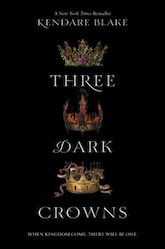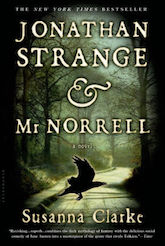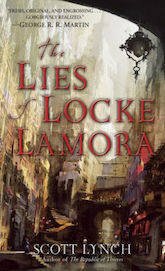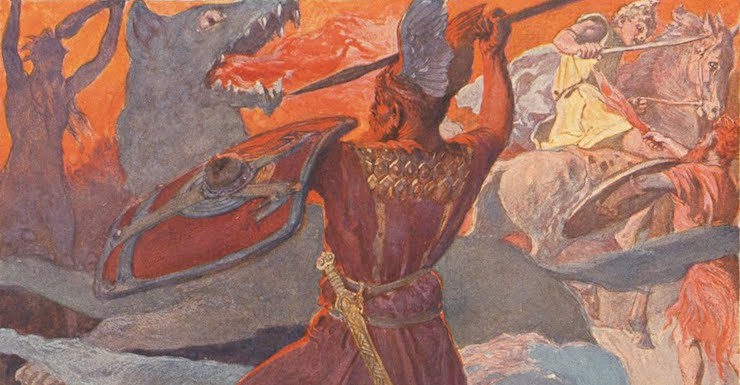Fantasy + Norse. It makes sense. Many dragon/dragonslayer tropes originated in Beowulf or the Volsunga Saga, not to mention elves, dwarves, trolls, and giants. In 1930 Tolkien hired an Icelandic nanny for his children, and she taught him the Norse mythology and Icelandic folk stories that would influence all of his writing, and, in turn, a lot of future fantasy. Here are five books with classic fantasy elements that echo Norse myth.
WEIRD SISTERS
Three Dark Crowns by Kendare Blake
 Rowling once said she adored Shakespeare’s Macbeth, and that it inspired the Harry Potter books, particularly the scene of Macbeth meeting the three witches. Shakespeare’s three witches, in turn, are often thought to have their roots in both the Greek Fates and the Norse Norns—three women who spin the threads of fate at the foot of Yggdrasil, the World Tree. Witches, witches, witches. In Blake’s Three Dark Crowns, three witch-sisters must fight to the death for the right to be queen—one is an elemental, one a poisoner, one a naturalist. This is brutal, bloody witch-fantasy at its best.
Rowling once said she adored Shakespeare’s Macbeth, and that it inspired the Harry Potter books, particularly the scene of Macbeth meeting the three witches. Shakespeare’s three witches, in turn, are often thought to have their roots in both the Greek Fates and the Norse Norns—three women who spin the threads of fate at the foot of Yggdrasil, the World Tree. Witches, witches, witches. In Blake’s Three Dark Crowns, three witch-sisters must fight to the death for the right to be queen—one is an elemental, one a poisoner, one a naturalist. This is brutal, bloody witch-fantasy at its best.
WIZARD IN A FLOPPY HAT
Jonathan Strange & Mr Norrell by Susanna Clarke
 The Lord of the Rings is teeming with Norse myths and Norse beasts, but even the concept of Gandalf’s wide-brimmed hat traces back to the sagas. Odin often wandered the land disguised as a traveler, and was described as having a long, white beard, a cloak, a staff, and a floppy hat.
The Lord of the Rings is teeming with Norse myths and Norse beasts, but even the concept of Gandalf’s wide-brimmed hat traces back to the sagas. Odin often wandered the land disguised as a traveler, and was described as having a long, white beard, a cloak, a staff, and a floppy hat.
I adore how Susanna Clarke played with this trope in Jonathan Strange and Mr Norrell. Early on, Jonathan is subtly referred to as the Knight of Wands, which is depicted on the Marseilles Tarot—the deck that the (secret protagonist) Childermass uses in the novel—as a man in a large-brimmed hat, carrying a staff. Jonathan Strange does become a wizard/magician, and a wandering one at that . . . though he never grows the beard.
*Jonathan Strange & Mr Norrell also features LOST WOODS.
LOST WOODS
Uprooted by Naomi Novik
 Norse legend speaks of an unknown “Mirkwood”—a vast forest which is wild and unexplored. The Prose Edda also mention an “Iron-Wood,” which is a forest stalked by large wolves and giants. This idea of a dark, lost wood obviously inspired Tolkien, but one of my favorite uses of this trope is Naomi Novik’s Uprooted. The corrupted woods in this book aren’t populated with elves or giant spiders, but with Walkers—evil, enchanted creatures who entomb people in trees and feed off their flesh.
Norse legend speaks of an unknown “Mirkwood”—a vast forest which is wild and unexplored. The Prose Edda also mention an “Iron-Wood,” which is a forest stalked by large wolves and giants. This idea of a dark, lost wood obviously inspired Tolkien, but one of my favorite uses of this trope is Naomi Novik’s Uprooted. The corrupted woods in this book aren’t populated with elves or giant spiders, but with Walkers—evil, enchanted creatures who entomb people in trees and feed off their flesh.
*Uprooted also features a wizard, but one who definitely doesn’t wear a floppy hat.
WORLD TREE
The Night Circus by Erin Morgenstern
 Yggdrasil is the world tree in Norse myth, mentioned in the Poetic Edda and the Prose Edda. It’s an immense ash tree that connects the nine worlds, and often serves as a godlike symbol of eternity, balance, and harmony. I see the magical Wishing Tree in The Night Circus as a variant of the Yggdrasil. Circus patrons write wishes on candles and place them on the tree, giving it godlike qualities, similar to saying a prayer and lighting a candle in a church.
Yggdrasil is the world tree in Norse myth, mentioned in the Poetic Edda and the Prose Edda. It’s an immense ash tree that connects the nine worlds, and often serves as a godlike symbol of eternity, balance, and harmony. I see the magical Wishing Tree in The Night Circus as a variant of the Yggdrasil. Circus patrons write wishes on candles and place them on the tree, giving it godlike qualities, similar to saying a prayer and lighting a candle in a church.
LOVABLE TRICKSTER
The Lies of Locke Lamora by Scott Lynch
 Loki is the original lovable swindler, an original trickster god. He cuts off the hair of sleeping goddesses, he bites people, he shape-shifts, he lies (a lot), and in general he either helps or hinders the other gods, depending on his whims. Locke, in Lynch’s The Lies of Locke Lamora, is a thief with a heart of gold, and a trickster to the core—one who cons his way across the Venice-like Camorr with his gang of Gentleman Bastards. I have a deep weakness for this type of chaotic neutral character whose fearless cunning will inevitably win him great rewards, but also cost him dearly.
Loki is the original lovable swindler, an original trickster god. He cuts off the hair of sleeping goddesses, he bites people, he shape-shifts, he lies (a lot), and in general he either helps or hinders the other gods, depending on his whims. Locke, in Lynch’s The Lies of Locke Lamora, is a thief with a heart of gold, and a trickster to the core—one who cons his way across the Venice-like Camorr with his gang of Gentleman Bastards. I have a deep weakness for this type of chaotic neutral character whose fearless cunning will inevitably win him great rewards, but also cost him dearly.
 April Genevieve Tucholke is the author of Between the Devil and the Deep Blue Sea, Between the Spark and the Burn, and Wink Poppy Midnight. Her latest novel, The Boneless Mercies, is now available from Farrar, Straus & Giroux Books for Young Readers. She currently lives in Oregon with her husband.
April Genevieve Tucholke is the author of Between the Devil and the Deep Blue Sea, Between the Spark and the Burn, and Wink Poppy Midnight. Her latest novel, The Boneless Mercies, is now available from Farrar, Straus & Giroux Books for Young Readers. She currently lives in Oregon with her husband.










